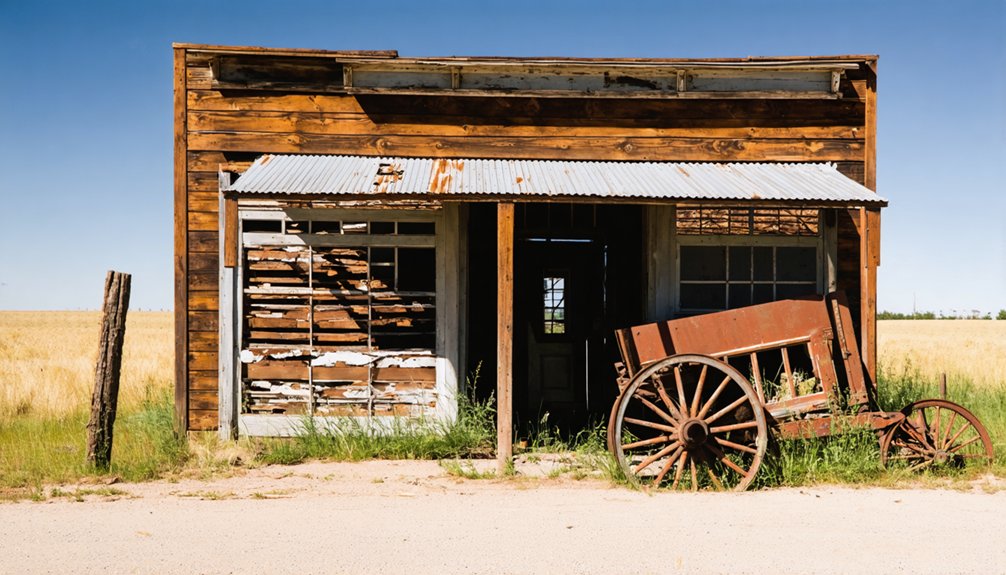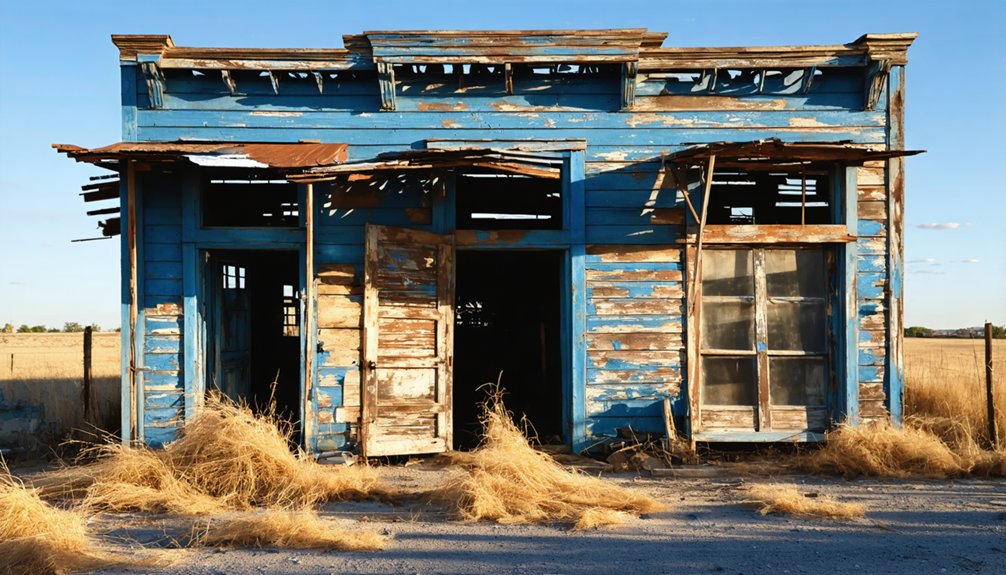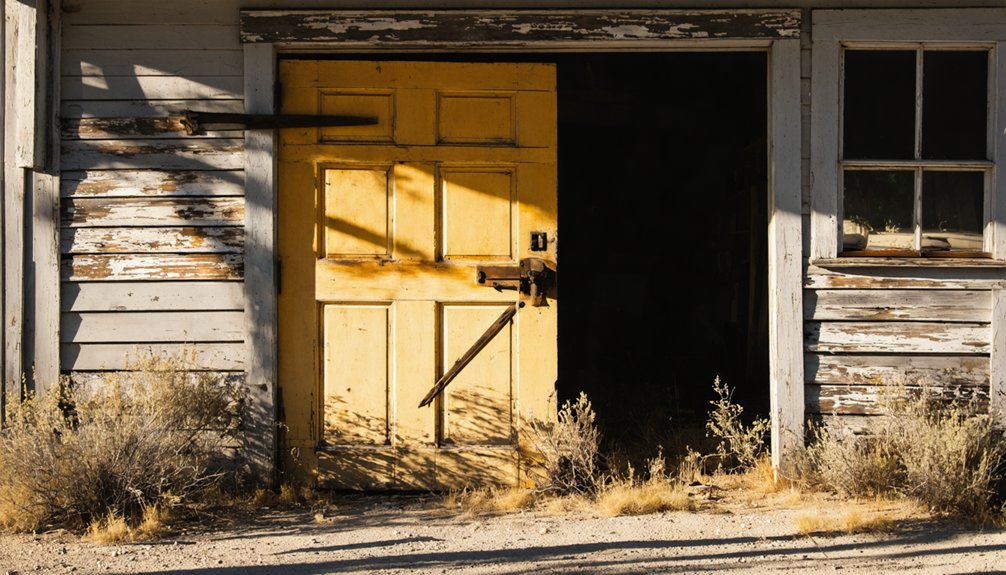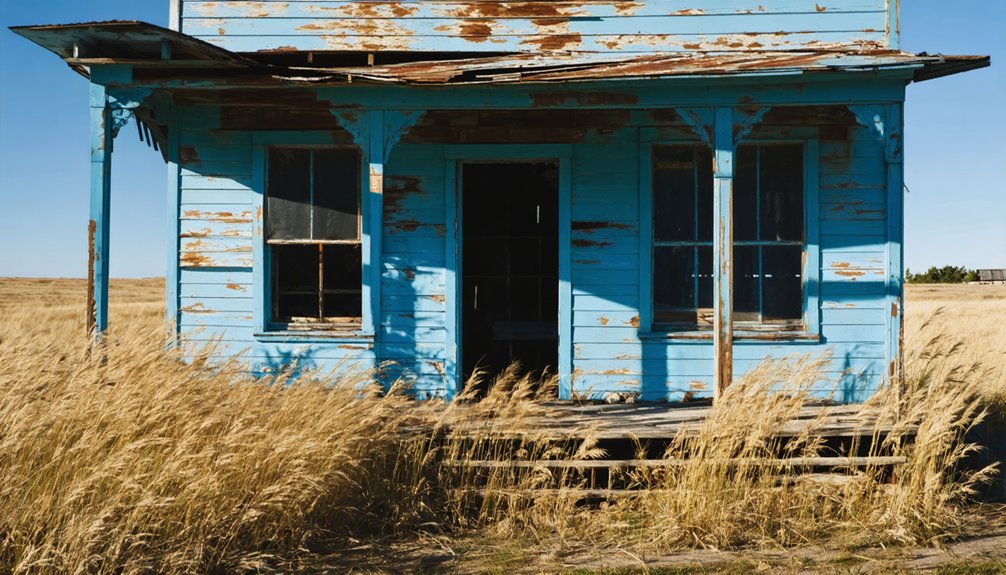You’ll find Quincy’s ghost town remnants in Texas’s upper Trinity region, where D.J. Swickhamer transformed Spanish hacienda lands into a promising settlement in 1891. The town briefly flourished with a post office, business house, and drugstore serving ranch hands and farmers. After a devastating fire and the challenges of geographic isolation, residents gradually abandoned Quincy for more prosperous communities. Today, silent prairie fields hold stories of ambitious pioneers and untold possibilities.
Key Takeaways
- Quincy began as a promising Texas settlement in the 1890s when D.J. Swickhamer purchased the Moya brothers’ hacienda to establish a township.
- The community featured a business house, post office, and drugstore, with the Texas and Pacific Railway supporting economic growth.
- A devastating fire severely damaged the town’s economic prospects, leading to population decline and business closures.
- Residents gradually abandoned Quincy in search of better opportunities, with unfavorable tax policies discouraging new development.
- Today, Quincy exists only in historical documentation, with no preserved landmarks remaining from its brief period of settlement.
The Birth of a Texas Settlement

While the removal of eastern Indian tribes opened vast tracts of land in Texas during the 1840s, it was the promise of free land that drew pioneers to the upper Trinity region.
You’ll find that early settlers faced significant settlement challenges as they established new homes along timbered creeks with rich, black soil. Despite the constant threat of flooding, pioneer resilience prevailed as they adapted their settlement patterns. Much like the Mormon refugee exodus of 1838, these settlers demonstrated remarkable fortitude in the face of hardship. The region attracted settlers with its fertile springs and waterways, similar to the natural features that made Adams County appealing to its first inhabitants.
Deputy surveyors like Dr. Rowlett played a vital role in helping you stake your claim, measuring and documenting land rights for incoming settlers.
The region’s appeal grew stronger with its abundant natural resources – from fertile Trinity soil perfect for farming to timber-lined waterways providing essential building materials.
As stockaded towns near the Red River gave way to more open settlements, you’d discover a landscape ripe with opportunity for those bold enough to claim it.
Ranch Land to Township Dreams
Three ambitious pioneers transformed the landscape of Blanco Creek when D.J. Swickhamer purchased the Moya brothers’ hacienda in 1891.
Along with N. King and the Enterprise Land and Colonization Company, they envisioned converting the vast ranch ownership into a thriving township.
Visionary entrepreneurs partnered with Enterprise Land Company to transform sprawling ranchland into a promising new settlement.
You’d have found their community aspirations taking shape through strategic development – a business house, post office, and drugstore emerged to serve the incoming Kansas settlers.
Like the conflict between Ayr and Grenada, Texas Rangers were called to maintain order during heated land disputes.
Families like the Bellesens, Halsells, and Larsons built substantial homes, marking their commitment to this new venture.
The settlement enjoyed its best activity during the warm winter months, when the climate was most favorable for daily life.
Yet dreams of a bustling town gradually faded. By 1958, the 10,500-acre expanse had returned to its ranching roots under the O’Briens’ management.
Today, only stubbled pastures and old house blocks remind you of Little Quincy’s brief existence as a hopeful settlement.
Life in Early Quincy
Life in early Quincy centered around four key struggles that shaped its brief existence: geographic isolation, sparse population, limited infrastructure, and agricultural challenges.
You’d have found a scattered community of ranch hands, farmers, and immigrant workers trying to carve out a living in this remote Texas outpost. The early demographics reflected the region’s European influences, with workers from Poland, Italy, Britain, and Ireland shaping the cultural landscape. Similar to Thurber’s practices, workers were forced to use company scrip for all their purchases.
Housing consisted mainly of simple ranch structures spread across the terrain, with no formal town center ever taking root. Without a post office or commercial district, social interactions remained informal and limited. You wouldn’t have found the typical markers of a thriving township – instead, the community gradually faded as settlers faced the harsh realities of limited resources and isolation. Like Cannonville’s fate during the Civil War period, the town’s development stalled as resources and attention were diverted elsewhere.
The Post Office Era
The establishment of Quincy’s post office in the early 1890s marked a brief period of promise for this struggling settlement. Under postmaster N. King, the office took on postal significance beyond mere mail delivery, serving as a crucial community hub where you’d find locals gathering to exchange news and conduct business.
You’d have seen the post office standing prominently among other early businesses, including a large business house and drug store. It provided essential services like money orders and parcel post, connecting isolated ranchers and farmers to the outside world. Like the historic Thurber post office that connected miners abroad, the facility helped residents maintain vital links with distant family members. Texas’s remarkable collection of 511 ghost towns includes Quincy among its haunting reminders of frontier dreams.
Despite the Bee County Irrigation Syndicate’s later attempts to breathe new life into Quincy, the post office’s eventual closure mirrored the town’s decline. Today, you’ll find only stubbles in pastures where this once-hopeful settlement stood.
From Little Quincy to Ghost Town
You’ll find Quincy’s early settlement period marked by David Swickheimer’s investment and the Texas and Pacific Railway‘s arrival in 1873, establishing a promising frontier community one mile west of Dodd.
Much like steamboat traffic had fueled growth in other American towns during the 1850s, the town’s growth initially centered around railroad commerce and local ranching, but a devastating fire struck the heart of the settlement, critically damaging its economic prospects.
Similar to how Mexican land grants had attracted early settlers to Texas, the area drew hopeful pioneers seeking new opportunities.
After the fire, Quincy’s population steadily declined as residents relocated to more prosperous nearby towns like Bay City and Beeville, eventually leading to the community’s complete abandonment.
Early Settlement Period
During the early 1840s, settlers moved into North Texas after eastern Native American tribes were relocated, setting the stage for what would become Quincy, Texas.
You’ll find that early settlers were drawn to the region’s rich black soil and timbered creeks, perfect for farming and ranching.
The area’s transformation accelerated in 1891 when David Swickheimer purchased the 10,500-acre John Quincy Ranch from Augustin and Juan Moya.
The community dynamics centered around agriculture, with settlers utilizing creek water for irrigation and timber for construction.
While the population remained small, steady growth supported ranching operations and farming endeavors.
The establishment of a post office marked formal recognition of the settlement, reflecting the broader patterns of Texas frontier development in the late 19th century.
Growth and Community Life
While Quincy emerged as a promising settlement in Bee County during the late 19th century, its path from bustling frontier town to ghost town unfolded through distinct phases of growth and decline.
You’d have found a diverse mix of settlers from Texas and the Midwest, drawn by the region’s agricultural potential and railroad connections. The town’s community cohesion centered around churches, schools, and seasonal celebrations tied to farming cycles.
Despite initial prosperity fueled by David Swickheimer’s mining wealth and agricultural trade, Quincy faced mounting economic challenges.
The town’s limited commercial diversification and infrastructure struggles began taking their toll. While locals maintained strong social bonds through church gatherings and school functions, younger residents increasingly sought opportunities elsewhere, marking the beginning of the town’s gradual decline.
Descent Into Abandonment
As economic and demographic pressures mounted in the early 20th century, Quincy’s descent into abandonment accelerated through a perfect storm of challenges.
You’ll find that the economic impact hit hardest when key businesses shuttered their doors, including the post office that had been essential to the community’s connectivity.
The town’s isolation grew as transportation routes changed, bypassing Quincy entirely.
The community decline became evident as families moved away seeking better opportunities.
Poor local management and insufficient investment in infrastructure left the remaining residents with few options.
When agricultural practices shifted and environmental challenges struck, Quincy couldn’t adapt.
The final blow came from unfavorable tax policies and zoning regulations that discouraged new development, sealing the town’s fate as another Texas ghost town.
The Vanishing Community

Despite its promising start as a settlement founded by the Enterprise Land and Colonization Company in 1891, Quincy’s community began to dissolve before it could establish deep roots.
The early signs of community resilience were promising – you’d have found a bustling post office, Dr. Palmer’s drug store, and several family residences dotting the landscape. Yet, the historical significance of this Texas settlement couldn’t overcome its mounting challenges.
As settlers from Kansas, including the Bellesen, Halsell, and Walker families, gradually moved away, Quincy’s liveliness faded.
Even attempts at revival by the Bee County Irrigation Syndicate, which built a service station, clubhouse, and store, couldn’t stem the exodus.
The town’s isolation and limited infrastructure ultimately sealed its fate, leaving behind only scattered house blocks and pasture stubbles as silent witnesses to its existence.
Legacy of the Land
Today’s silent prairie fields at Quincy reveal little of its ambitious transformation from the Juan and Augustin Moya hacienda into a planned settlement by D.J. Swickhamer in 1891.
You’ll find traces of early Texas development dreams in the stubbled pastures where the Enterprise Land and Colonization Company once envisioned a thriving community complete with stores, homes, and a post office.
While the town didn’t survive, the land’s legacy endures through the O’Brien family’s ranching operations, which maintained over 10,500 acres of the original property into the late 1950s.
Ranch to Ghost Town
When settlement began in Quincy during 1839, Maj. Edmund Hall Dodd and his wife established the first homestead, marking the start of changing settlement patterns in the region.
You’ll find that the land’s agricultural heritage evolved from Spanish haciendas to the expansive John Quincy Ranch, which covered over 10,500 acres by 1958.
Though early development showed promise with Kansas families moving in and infrastructure like a post office and drug store emerging, the town’s future wasn’t secure.
The Bee County Irrigation Syndicate tried reviving the declining community by building a clubhouse and store, but their efforts fell short.
As settlers departed, the town gradually faded into memory, leaving only stubble patches and house blocks known as “Little Quincy” to mark where a thriving community once stood.
Property Development Dreams
The legacy of Quincy’s land presents unique opportunities for modern property development, even as its ghost town status persists.
If you’re considering property revitalization in this historic area, you’ll need to navigate both challenges and possibilities. The site’s 1891 origins offer compelling heritage value, but you’ll face significant infrastructure needs and regulatory hurdles.
Success in transforming Quincy depends heavily on community engagement and strategic planning. You’ll need to address aging structures, upgrade essential utilities, and comply with local zoning requirements.
However, the potential rewards are substantial – from tourism revenue to increased property values. By incorporating innovative designs that honor the town’s ranching heritage while meeting modern needs, you can create a sustainable development that preserves Quincy’s unique historical character.
Silent Prairie Today
Sprawling across what remains of Texas’s historic blackland prairies, Silent Prairie stands as a living tribute to the region’s natural heritage, though now severely fragmented by development.
You’ll find rescued native plants along bike paths and protected zones, indication to the 12-million-acre ecosystem that once stretched from the Red River to San Antonio.
Conservation efforts focus on prairie ecology through innovative approaches. Dedicated naturalists have mapped sensitive areas and transplanted indigenous species, even conducting covert rescue operations in the 1980s to preserve genetic material.
While medical complexes and urban growth continue to threaten the landscape, local nurseries work to propagate native flora. The prairie’s biodiversity preservation remains an ongoing challenge, balancing modern progress with the protection of this essential ecological legacy.
Lost Places of Bee County
Among Bee County’s vanished settlements, Quincy stands as a tribute to the region’s boom-and-bust legacy of the late 1800s.
You’ll find its historical significance deeply rooted in the Juan and Augustin Moya hacienda, which later became the John Quincy Ranch before D.J. Swickhamer’s 1891 subdivision.
While the Enterprise Land and Colonization Company drew hopeful Kansas families to this prairie town, agricultural challenges proved formidable.
Despite the Bee County Irrigation Syndicate’s determined efforts along Blanco Creek, the settlement couldn’t sustain its early promise.
What was once a bustling community with a post office, drug store, and various businesses now lies silent.
The O’Brien family’s vast 10,500-acre holdings in 1958 marked one of the few remaining legacies of this lost Texas prairie town.
What Remains Today

Today if you visit Quincy, you’ll find typical ghost town remnants including abandoned building foundations and scattered ruins overtaken by vegetation.
You can trace some of the town’s physical history through county records and historical documents maintained at the Bee County courthouse.
The town’s cemetery, like those of many Texas ghost towns, remains as one of the few tangible connections to Quincy’s past community.
Physical Site Today
Unlike many Texas ghost towns that leave visible traces of their past, Quincy has completely vanished from the physical landscape. You won’t find any structural remnants, foundations, or ruins marking the town’s former location.
The site’s exact boundaries have been lost to time, with no visible markers or signs indicating where this community once stood.
The absence of Quincy remnants makes it distinct from other ghost towns in Texas, where you might typically discover old churches, abandoned storefronts, or crumbling homesteads.
The historical significance of the site exists now only in documentation, as there are no preserved landmarks or architectural features to explore.
Even the surrounding landscape offers no clues to its past existence, leaving visitors with nothing tangible to connect to its former presence.
Local Records Available
Although physical traces of Quincy have vanished, substantial historical documentation preserves the town’s legacy through various official records.
You’ll find detailed accounts in local archives, including post office records naming King as postmaster and property documents tracking the land’s change from Moya family hacienda to John Quincy Ranch.
The Enterprise Land and Colonization Company’s records reveal early settler families from Kansas, while the 1958 Bee County Centennial publications document the O’Brien family’s 10,500-acre ranch.
Historical documentation at the University of North Texas Libraries’ Texas Ghost Town Newspaper Collection offers period newspapers with relevant narratives.
Business records confirm Dr. C.B. Palmer’s drug store operations, and county records detail the Bee County Irrigation Syndicate’s revival attempts through infrastructure development.
Preserving Quincy’s Memory
While many Texas ghost towns maintain active historical societies and preservation programs, Quincy’s legacy remains largely undocumented and unpreserved.
Despite Texas’s rich tradition of ghost town preservation, Quincy stands as a forgotten chapter in the state’s history, awaiting rediscovery.
You’ll find no dedicated preservation group safeguarding its historical significance, unlike neighboring communities such as Helena, where community involvement has protected landmarks like their abandoned courthouse.
You can help preserve Quincy’s memory through these proven approaches:
- Support digital archiving efforts through the University of North Texas Libraries’ newspaper collection
- Document physical remnants through photography and video for the Portal to Texas History
- Organize community events similar to other ghost towns’ Victorian Tea Parties and heritage festivals
The town’s origins from the 10,500-acre John Quincy ranch deserve recognition, and it’s not too late to protect what remains of this piece of Texas history.
Frequently Asked Questions
Were There Any Schools or Churches Established During Quincy’s Existence?
While records don’t confirm specific school buildings or church services, you’ll find that both likely existed, as they were standard features in similar Texas towns during that settlement period.
What Was the Peak Population of Quincy Before Its Decline?
Quincy’s peak population reached over 400 residents in the mid-1880s when you’d find a thriving local economy with twenty businesses. Despite lacking major transportation developments, it was among Fannin County’s largest communities.
Did Any Notable Crimes or Incidents Occur in Quincy?
You won’t find any documented notable crimes or incidents in Quincy’s records. Unlike other Texas ghost towns, there’s no evidence of significant violence, murders, or criminal activity during its existence.
Was There a Cemetery Associated With the Quincy Community?
You won’t find definitive records of a cemetery in this community’s history. While burial practices were common in Texas ghost towns, existing historical documentation doesn’t confirm any established burial grounds here.
Did Any Famous or Notable People Ever Live in Quincy?
While you might expect famous residents given the area’s historical significance, records don’t show any nationally recognized figures. You’ll find mostly local settlers, ranchers, and business owners like postmaster N. King.
References
- https://en.wikipedia.org/wiki/Quincy_(ghost_town)
- https://www.texasalmanac.com/places/quincy-0
- https://en.wikipedia.org/wiki/List_of_ghost_towns_in_Texas
- https://www.quincyvagell.com/2021/03/13/tornado-ghost-town/
- https://www.ghosttowns.com/states/tx/quincy.html
- https://www.texasescapes.com/TOWNS/Texas-Ghost-Towns-8-South-Texas.htm
- https://www.texasescapes.com/SouthTexasTowns/QuincyTexas.htm
- https://www.tshaonline.org/handbook/entries/quincy-tx
- https://texashistory.unt.edu/ark:/67531/metapth752794/m2/1/high_res_d/Between _the_Creeks_by_Gwen_Pettit_compiled_by_Melinda_Fisher.pdf
- https://ensignpeakfoundation.org/mormon-quincy-interpretive-center/



